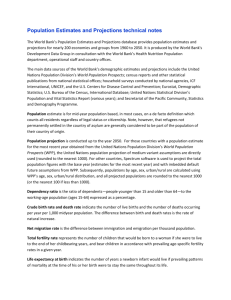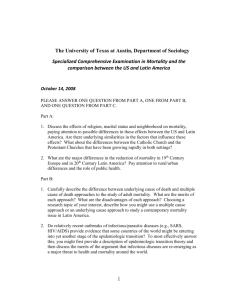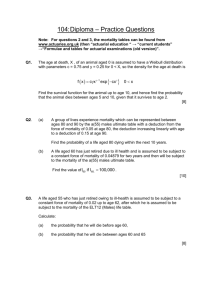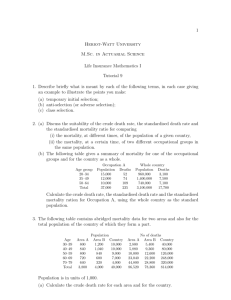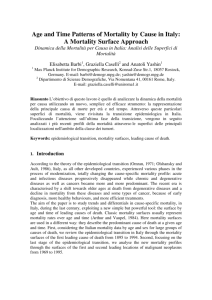Electronic Supplementary Material:
advertisement
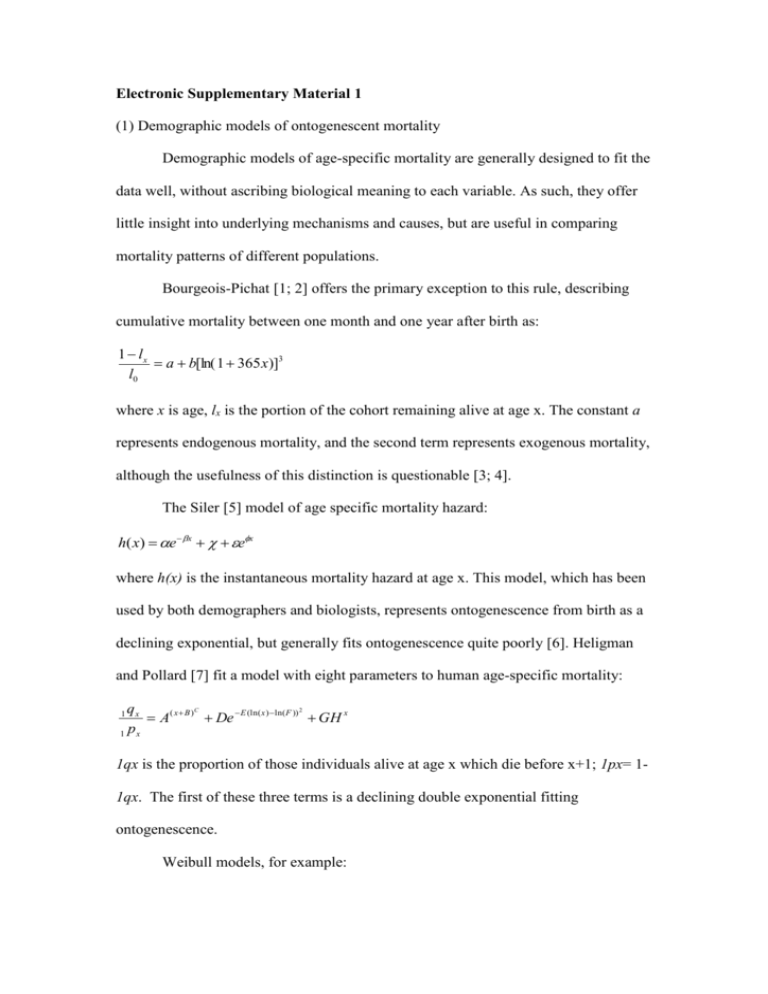
Electronic Supplementary Material 1 (1) Demographic models of ontogenescent mortality Demographic models of age-specific mortality are generally designed to fit the data well, without ascribing biological meaning to each variable. As such, they offer little insight into underlying mechanisms and causes, but are useful in comparing mortality patterns of different populations. Bourgeois-Pichat [1; 2] offers the primary exception to this rule, describing cumulative mortality between one month and one year after birth as: 1 lx a b[ln( 1 365 x)]3 l0 where x is age, lx is the portion of the cohort remaining alive at age x. The constant a represents endogenous mortality, and the second term represents exogenous mortality, although the usefulness of this distinction is questionable [3; 4]. The Siler [5] model of age specific mortality hazard: h( x) e x ex where h(x) is the instantaneous mortality hazard at age x. This model, which has been used by both demographers and biologists, represents ontogenescence from birth as a declining exponential, but generally fits ontogenescence quite poorly [6]. Heligman and Pollard [7] fit a model with eight parameters to human age-specific mortality: C 2 qx A( x B ) De E (ln(x ) ln(F )) GH x 1 px 1 1qx is the proportion of those individuals alive at age x which die before x+1; 1px= 11qx. The first of these three terms is a declining double exponential fitting ontogenescence. Weibull models, for example: x x can also be fit to ontogenetic mortality curves, as is often done in the public health field [8; 9]. Parameterization's designed to represent biological hypotheses will fit data on ontogenescence poorly if they do not in form resemble these demographic models. References: 1. Bourgeois-Pichat, J. 1946 De la mesure de la mortalité infantile. Population 1, 5368. 2. Bourgeois-Pichat, J. 1951 La mesure de la mortalité infantile. II. Les causes de décès. Population 6, 459-480. 3. Wilmoth, J. R. 1997 In search of limits. In Between Zeus and the salmon: The biodemography of longevity (ed. K. W. Wachter), pp. 38-64. Washington, DC: National Academies Press. 4. Carnes, B. A., Holden, L. R., Olshansky, S. J., Witten, M. T. & Siegel, J. S. 2006 Mortality partitions and their relevance to research on senescence. Biogerontology 7, 183-198. 5. Siler, W. 1979 A competing-risk model for animal mortality. Ecology 60, 750-757. 6. Gage, T. B. 1998 The comparative demography of primates: with some comments on the evolution of life histories. Annual Review of Anthropology 27, 197-221. 7. Heligman, L. & Pollard, J. H. 1980 The age pattern of mortality. Journal of the Institute of Actuaries 107, 49–80. 8. Lee, E. T. & Go, O. T. 1997 Survival analysis in public health research. Annu. Rev. Public Health 18, 105-134. 9. Ndirangu, J., Newell, M. L., Tanser, F., Herbst, A. J. & Bland, R. 2010 Decline in early life mortality in a high HIV prevalence rural area of South Africa: evidence of HIV prevention or treatment impact? AIDS 24, 593.




